WBR3D Module Datasheet
Last Updated on : 2025-11-17 08:19:43download
WBR3D is a low-power embedded Wi-Fi and Bluetooth module that Tuya has developed. It consists of a highly integrated RF chip (W701D-VA1-CG) and several peripheral components, with an embedded Wi-Fi network protocol stack, Bluetooth network protocol, and robust library functions.
Overview
WBR3D is embedded with a low-power 32-bit CPU, 512 KB static random-access memory (SRAM), and 4 MB flash memory, and has extensive peripherals.
WBR3D is an RTOS platform that integrates all function libraries of the Wi-Fi MAC and TCP/IP protocols. You can develop embedded Wi-Fi products as required.
Features
- Embedded low-power 32-bit CPU, which can also function as an application processor
- Dominant frequency: up to 200 MHz
- Operating voltage: 3.0 V to 3.6 V
- Peripherals: 8 GPIOs, 1 UART, and 1 ADC
- Wi-Fi connectivity
- 802.11a/b/g/n 1T1R, 2.4 GHz and 5 GHz capable
- Channels 1 to 14 at 2.4 GHz and channels 36 to 177 at 5 GHz
- Support WEP, WPA/WPA2, and WPA2 PSK (AES), WPA3 security modes
- Up to +17 dBm output power in 802.11b mode and up to +15 dBm in 802.11a mode
- STA, AP, and STA+AP working modes
- Smart and AP network configuration modes for Android and iOS devices
- Onboard PCB antenna with a gain of 2dBi in 2.4G band, and 2.6dBi of 5G band
- Operating temperature: -20°C to +85°C
- Bluetooth connectivity
- Support Bluetooth (V5.0)
- Up to +8dBm TX power
- Onboard PCB antenna with a gain of 2dBi in 2.4G band
- Operating temperature: -20°C to +85°C
Applications
- Intelligent building
- Smart household and home appliances
- Smart socket and light
- Industrial wireless control
- Baby monitor
- Network camera
- Intelligent bus
Module interfaces
Dimensions and footprint
WBR3D has two rows of pins with a 2±0.1 mm pin spacing.
WBR3D dimensions (H x W x L): 2.9 mm ±0.15; 16 mm ±0.35; 24 mm ±0.35.
The front and rear views of WBR3D:
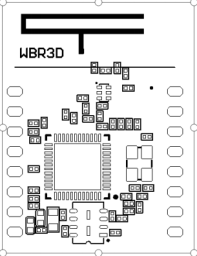
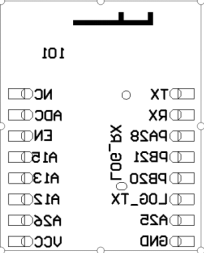
Interface pin definition
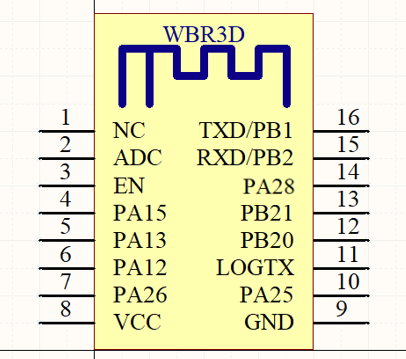
| Pin No. | Symbol | I/O type | Function |
|---|---|---|---|
| 1 | NC | I/O | No Connection |
| 2 | ADC | AI | 10-bit precision SAR ADC(1), the Pin PB3 of IC |
| 3 | EN | I | Module enabling pin, which is connected to 3.3 V for normal use, refer to the CHIP_EN of IC |
| 4 | PA15 | I/O | GPIO, The pin PA15 of IC |
| 5 | PA13 | P | PWM Pin, The pin PA13 of IC |
| 6 | PA12 | I/O | PWM Pin, The pin PA12 of IC |
| 7 | PA26 | I/O | PWM Pin, The pin PA26 of IC |
| 8 | VCC | P | Power supply pin (3.3 V) |
| 9 | GND | P | Power supply reference ground pin |
| 10 | PA25 | O | PWM Pin, The pin PA25 of IC |
| 11 | LOG_TX | O | UART0_TXD (used to display the module internal information) |
| 12 | PB20 | I/O | PWM Pin, The pin PB20 of IC |
| 13 | PB21 | I/O | PWM Pin, The pin PB21 of IC |
| 14 | PA28 | I/O | PWM Pin, The pin PA28 of IC |
| 15 | RXD/PB2 | I/O | UART0_RXD (2), refer to the PB2 of IC |
| 16 | TXD/PB1 | I/O | UART0_TXD(2), refer to the PB1 of IC |
Pindicates power supply pins,I/Oindicates input/output pins, andAIindicates analog input pins.- (1): This pin can only function as an ADC input and not a common I/O. If this pin is not used, it must be disconnected. When this pin is used as the ADC input, the input voltage range is 0 V to 1.0 V.
- (2): UART0 is a user-side serial interface, which generates information when the module is powered on and starts.
Test pin definition
| Pin No. | Symbol | I/O type | Function |
|---|---|---|---|
| - | TEST | I | Used for the module production test |
Test pins are not recommended.
Electrical parameters
Absolute electrical parameters
| Parameter | Description | Minimum value | Maximum value | Unit |
|---|---|---|---|---|
| Ts | Storage temperature | -20 | 85 | ℃ |
| VBAT | Power supply voltage | 3.0 | 3.6 | V |
| ESD voltage (human body model) | TAMB-25℃ | - | 2 | KV |
| ESD voltage (machine model) | TAMB-25℃ | - | 0.5 | KV |
Normal electrical conditions
| Parameter | Description | Minimum value | Typical value | Maximum value | Unit |
|---|---|---|---|---|---|
| Ta | Operating temperature | -20 | - | 85 | ℃ |
| VBAT | Power supply voltage | 3.0 | 3.3 | 3.6 | V |
| VIL | I/O low-level input | -0.3 | - | VCC*0.25 | V |
| VIH | I/O high-level input | VCC*0.75 | - | VCC | V |
| VOL | I/O low-level output | - | - | VCC*0.1 | V |
| VOH | I/O high-level output | VCC*0.8 | - | VCC | V |
| Imax | I/O drive current | - | - | 12 | mA |
Current during constant transmission and receiving
2.4G transmission and receive
| Working status | Mode | Rate | TX power/Receive | Typical value | Unit |
|---|---|---|---|---|---|
| TX | 11b | 11Mbps | +18dBm | 250 | mA |
| TX | 11g | 54Mbps | +17dBm | 180 | mA |
| TX | 11n-HT20 | MCS7 | +16dBm | 170 | mA |
| TX | 11n-HT40 | MCS7 | +16dBm | 150 | mA |
| RX | 11b | 11Mbps | Receiving | 70 | mA |
| RX | 11g | 54Mbps | Receiving | 72 | mA |
| RX | 11n-HT20 | MCS7 | Receiving | 70 | mA |
| RX | 11n-HT40 | MCS7 | Receiving | 73 | mA |
5G transmission and receive
| Working status | Mode | Rate | TX power/Receive | Typical value | Unit |
|---|---|---|---|---|---|
| TX | 11a | 54Mbps | +15dBm | 300 | mA |
| TX | 11n-HT20 | MCS7 | +15dBm | 230 | mA |
| TX | 11n-HT40 | MCS7 | +14dBm | 220 | mA |
| RX | 11a | 54Mbps | Receiving | 71 | mA |
| RX | 11n-HT20 | MCS7 | Receiving | 72 | mA |
| RX | 11n-HT40 | MCS7 | Receiving | 76 | mA |
Operating current
| Working mode | Working status, TA = 25°C | Average value | Peak value (Typical value) | Unit |
|---|---|---|---|---|
| Fast network configuration (AP) | The module is in fast network configuration state and the Wi-Fi indicator flashes slowly. | 45.7 | 688 | mA |
| Fast network configuration (Bluetooth) | The module is in Bluetooth pairing state and the Wi-Fi indicator flashes fast. | 44.2 | 607 | mA |
| No operation during network connection | The module is in an idle networking working state and the Wi-Fi indicator is always on. | 41.8 | 368 | mA |
| Operations are being performed during network connection | The module is in a networked operational state and the Wi-Fi indicator is always on. | 45.4 | 376 | mA |
| Weak network state | The module is in a wireless signal weak network connection working state and the Wi-Fi indicator is off. | 45.5 | 376 | mA |
| Disconnected state | The module is disconnected and the Wi-Fi indicator is off. | 43.3 | 360 | mA |
| The router is not powered | The module is in a working state where the router is powered off and disconnected from the internet and the Wi-Fi indicator is off. | 58.6 | 368 | mA |
The above data module is powered by a DC steady-state power supply at 3.3 V and is based on the Tuya single-plug firmware, with firmware version v1.0.4. Test data may vary slightly due to differences in firmware versions, modules, and power supplies.
RF features
Basic RF features
| Parameter | Description |
|---|---|
| Frequency band | 2.412~2.484GHz; 5.180~5.885GHz |
| Wi-Fi standard | IEEE 802.11a/b/g/n (Channels 1 to 14 and 36 to 177) |
| Data transmission rate | 802.11b: 1, 2, 5.5, or 11 (Mbit/s);802.11a/g: 6, 9, 12, 18, 24, 36, 48, or 54 (Mbit/s);802.11n: HT20 MCS0 to MCS7;802.11n: HT40 MCS0 to MCS7 |
| Antenna type | PCB antenna with a gain of 2 dBi at 2.4 GHz and 2.6 dBi at 5 GHz |
TX performance
Performance during constant transmission at 2.4 GHz:
| Parameter | Minimum value | Typical value | Maximum value | Unit |
|---|---|---|---|---|
| Average RF output power, 802.11b CCK mode 11M | - | 17 | - | dBm |
| Average RF output power, 802.11g OFDM Mode 54M | - | 16 | - | dBm |
| Average RF output power, 802.11n HT20 Mode MCS7 | - | 15 | - | dBm |
| Average RF output power, 802.11n HT40 Mode MCS7 | - | 14 | - | dBm |
| Frequency error | -10 | - | 10 | ppm |
Performance during constant transmission at 5 GHz:
| Parameter | Minimum value | Typical value | Maximum value | Unit |
|---|---|---|---|---|
| Average RF output power, 802.11aOFDM Mode 54M | - | 15 | - | dBm |
| Average RF output power, 802.11n HT20 Mode MCS7 | - | 14 | - | dBm |
| Average RF output power, 802.11n HT40 Mode MCS7 | - | 13 | - | dBm |
| Frequency error | -10 | - | 10 | ppm |
RX performance
RX sensitivity
| Parameter | Minimum value | Typical value | Maximum value | Unit |
|---|---|---|---|---|
| PER<8%, 802.11b DSSS Mode 11M | - | -91 | - | dBm |
| PER<10%, 802.11a/g OFDM Mode 54 M | - | -75 | - | dBm |
| PER<10%, 802.11n OFDM Mode HT20-MCS7 | - | -72 | - | dBm |
Antenna
Antenna Type
WBR3T uses an onboard PCB antenna.
Antenna interference reduction
To ensure optimal Wi-Fi performance when the Wi-Fi module uses an onboard PCB antenna, it is recommended that the antenna be at least 15 mm away from other metal parts.
To prevent adverse impact on the antenna radiation performance, avoid copper or traces along the antenna area on the PCB. Ensure that there are no substrate media above or below the antenna and that copper is at a certain distance away from the antenna to maximize the antenna radiation performance.
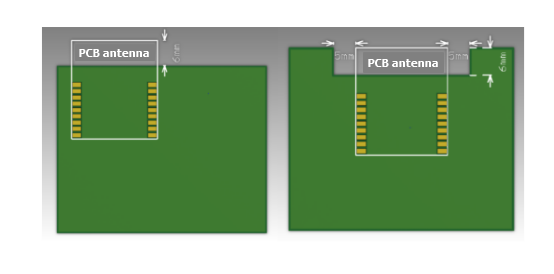
GPIO pin processing
Module individual pin (PA15 PA12, PA13, PA25, PA28, PA26) before the chip didn’t completely work. It will be an instantaneous high-level pulse, But everything is ok after the chip work. For these pins, if used directly as a driver of light source or relay, the following reference processing can be done to avoid the effect of instant burr during the power on.
Pull-down a 1K resistor at the output port of the pin, then series a diode, and the VOLTAGE of GPIO will drop to about 2.7V after passing the diode. The red frame represents the original drive tube on the customer bottom plate, diode D1 and drops 1K needs to be added.
If the lamp class is driven directly, then the 10K resistor is pulled down from the gate of the MOS tube. If the lamp class is not driven directly and the PWM signal is not sent until the module is formally set up, then there is no need to add the pull-down resistor and diode.
If the relay is driven, the diode can be replaced with 0 ohms according to the actual situation.
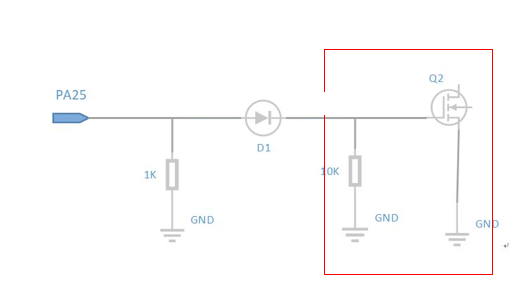
Packaging information and production instructions
Mechanical dimensions
PCB mechanical dimensions: 16±0.35 mm (W)×24±0.35 mm (L) ×0.8±0.1 mm (H).

Side view
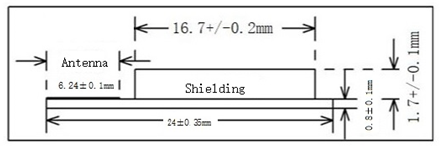
Schematic packaging
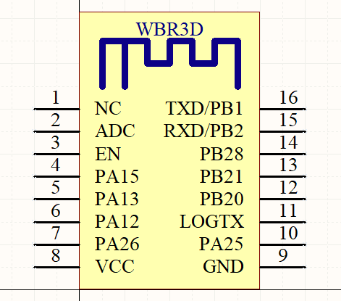
Recommended PCB encapsulation
PCB encapsulation-SMT
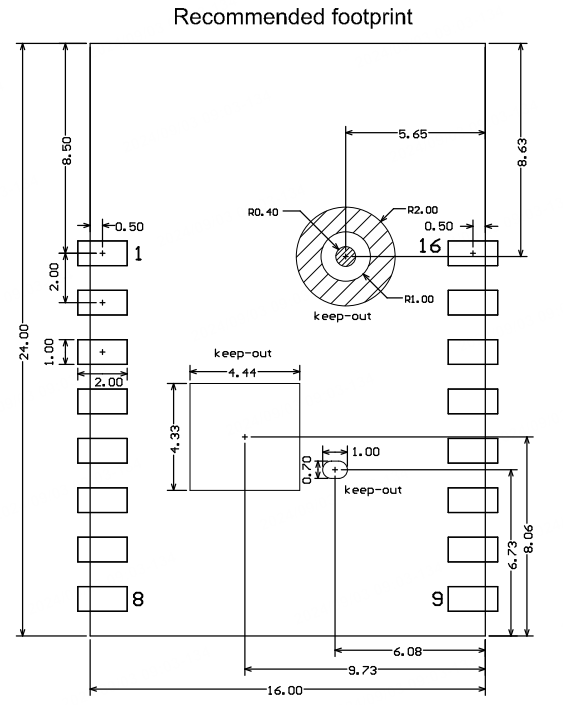
The area indicated as keep-out in the diagram above does not require tinning and should not have any traces routed through it.
Production instructions
- The Tuya SMT module should be mounted by the SMT device. After being unpacked, it should be soldered within 24 hours. Otherwise, it should be put into the drying cupboard where the RH is not greater than 10%; or it needs to be packaged under vacuum again and the exposure time needs to be recorded (the total exposure time cannot exceed 168 hours).
- SMT devices:
- Mounter
- SPI
- Reflow soldering machine
- Thermal profiler
- Automated optical inspection (AOI) equipment
- Baking devices:
- Cabinet oven
- Anti-electrostatic and heat-resistant trays
- Anti-electrostatic and heat-resistant gloves
- SMT devices:
- Storage conditions for a delivered module:
-
The moisture-proof bag must be placed in an environment where the temperature is below 40°C and the relative humidity is lower than 90%.
-
The shelf life of a dry-packaged product is 12 months from the date when the product is packaged and sealed.
-
There is a humidity indicator card (HIC) in the packaging bag.
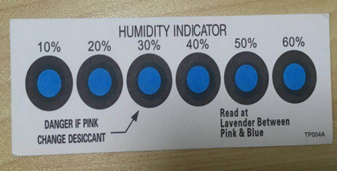
-
- The module needs to be baked in the following cases:
- The packaging bag is damaged before unpacking.
- There is no HIC in the packaging bag.
- After unpacking, circles of 10% and above on the HIC become pink.
- The total exposure time has lasted for over 168 hours since unpacking.
- More than 12 months have passed since the sealing of the bag.
- Baking settings:
- Temperature: 40°C and ≤ 5% RH for reel package and 125°C and ≤5% RH for tray package (please use the heat-resistant tray rather than a plastic container)
- Time: 168 hours for reel package and 12 hours for tray package
- Alarm temperature: 50°C for reel package and 135°C for tray package
- Production-ready temperature after natural cooling: < 36°C
- Re-baking situation: If a module remains unused for over 168 hours after being baked, it needs to be baked again.
- If a batch of modules is not baked within 168 hours, do not use the wave soldering to solder them. Because these modules are Level-3 moisture-sensitive devices, they are very likely to get damp when exposed beyond the allowable time. In this case, if they are soldered at high temperatures, it may result in device failure or poor soldering.
- In the whole production process, take electrostatic discharge (ESD) protective measures.
- To guarantee the passing rate, it is recommended that you use the SPI and AOI to monitor the quality of solder paste printing and mounting.
Recommended oven temperature curve
Set oven temperatures according to the following temperature curve of reflow soldering. The peak temperature is 245°C.
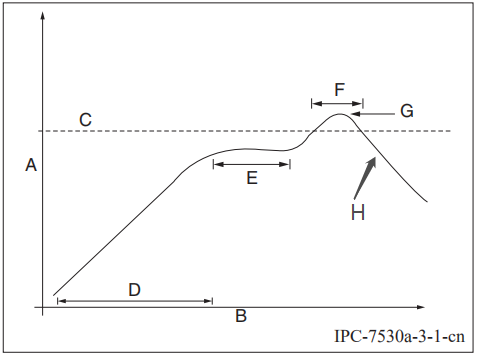
- A: Temperature axis
- B: Time axis
- C: Liquidus temperature: 217 to 220°C
- D: Ramp-up slope: 1 to 3°C/s
- E: Duration of constant temperature: 60 to 120s; the range of constant temperature: 150 to 200°C
- F: Duration above the liquidus: 50 to 70s
- G: Peak temperature: 235 to 245°C
- H: Ramp-down slope: 1 to 4°C/s
The above curve is just an example of the solder paste SAC305. For more details about other solder pastes, please refer to Recommended oven temperature curve in the solder paste specifications.
Storage conditions
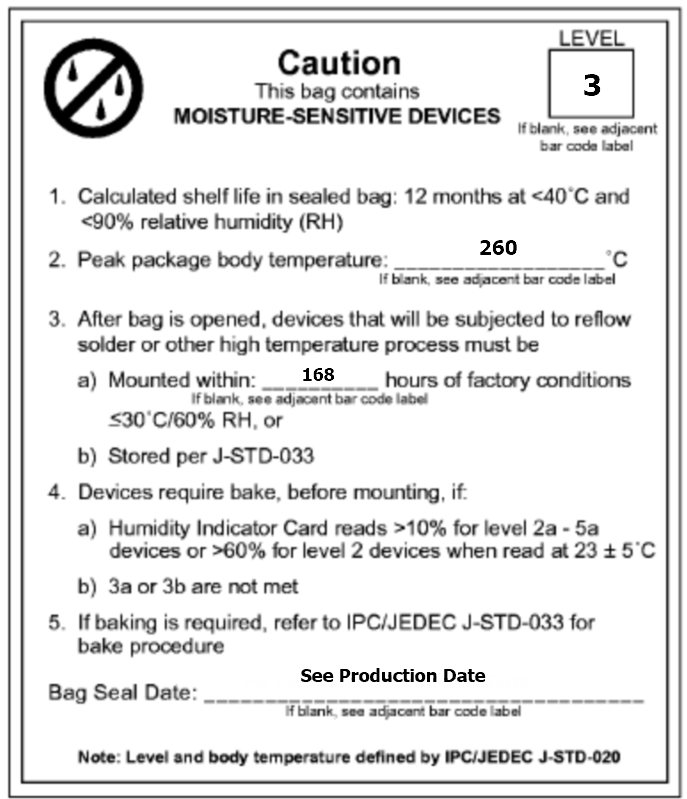
MOQ and packing information
| Product model | MOQ (pcs) | packing method | Number of modules per reel | Number of reels per carton |
|---|---|---|---|---|
| WBR3D | 4000 | Tape reel | 1000 | 4 |
Appendix: Statement
FCC Caution: Any changes or modifications not expressly approved by the party responsible for compliance could void the user’s authority to operate this device.
This device complies with Part 15 of the FCC Rules. Operation is subject to the following two conditions: (1) This device may not cause harmful interference, and (2) this device must accept any interference received, including interference that may cause undesired operation.
Note: This device has been tested and found to comply with the limits for a Class B digital device, according to part 15 of the FCC Rules. These limits are designed to provide reasonable protection against harmful interference in a residential installation. This device generates, uses, and can radiate radio frequency energy and, if not installed and used following the instructions, may cause harmful interference to radio communications. However, there is no guarantee that interference will not occur in a particular installation.
If this device does cause harmful interference to radio or television reception, which can be determined by turning the device off and on, the user is encouraged to try to correct the interference by one or more of the following measures:
- Reorient or relocate the receiving antenna.
- Increase the separation between the device and receiver.
- Connect the device into an outlet on a circuit different from that to which the receiver is connected.
- Consult the dealer or an experienced radio/TV technician for help.
Radiation Exposure Statement
This device complies with FCC radiation exposure limits set forth for an uncontrolled rolled environment. This device should be installed and operated with a minimum distance of 20cm between the radiator and your body.
Important Note
This radio module must not be installed to co-locate and operating simultaneously with other radios in the host system except following FCC multi-transmitter product procedures. Additional testing and device authorization may be required to operate simultaneously with other radios.
The availability of some specific channels and/or operational frequency bands are country-dependent and are firmware programmed at the factory to match the intended destination. The firmware setting is not accessible by the end-user.
The host product manufacturer is responsible for compliance with any other FCC rules that apply to the host not covered by the modular transmitter grant of certification. The final host product still requires Part 15 Subpart B compliance testing with the modular transmitter installed.
The end-user manual shall include all required regulatory information/warnings as shown in this manual, including “This product must be installed and operated with a minimum distance of 20 cm between the radiator and user body”.
This device has got an FCC ID: 2ANDL-WBR3D. The end product must be labeled in a visible area with the following: “Contains Transmitter Module FCC ID: 2ANDL-WBR3D”.
This device is intended only for OEM integrators under the following conditions:
The antenna must be installed such that 20cm is maintained between the antenna and users, and the transmitter module may not be co-located with any other transmitter or antenna.
As long as the 2 conditions above are met, further transmitter tests will not be required. However, the OEM integrator is still responsible for testing their end-product for any additional compliance requirements required with this module installed.
Declaration of Conformity European Notice

Hereby, Hangzhou Tuya Information Technology Co., Ltd declares that this module product is in compliance with essential requirements and other relevant provisions of Directive 2014/53/EU,2011/65/EU. A copy of the Declaration of conformity can be found at https://www.tuya.com.

This product must not be disposed of as normal household waste, in accordance with the EU directive for waste electrical and electronic equipment (WEEE-2012/19/EU). Instead, it should be disposed of by returning it to the point of sale, or to a municipal recycling collection point.
The device could be used with a separation distance of 20cm to the human body.
The device is restricted to indoor use only when operating in the 5250 to 5350 MHz frequency range.

Industry Canada Statement
This device complies with Industry Canada’s licence-exempt RSSs. Operation is subject to the following two conditions: (1) This device may not cause interference; and (2) this device must accept any interference, including interference that may cause undesired operation of the device.
Le présent appareil est conforme aux CNR d’Industrie Canada applicables aux appareils radio exempts de licence. L’exploitation est autorisée aux deux conditions suivantes: (1) l’appareil ne doit pas produire de brouillage, et (2) l’utilisateur de l’appareil doit accepter tout brouillage radioélectrique subi, même si le brouillage est susceptible d’en compromettre le fonctionnement."
Radiation Exposure Statement
This equipment complies with IC radiation exposure limits set forth for an uncontrolled environment. This equipment should be installed and operated with a minimum distance of 20 cm between the radiator & your body.
Déclaration d’exposition aux radiations
Cet équipement est conforme aux limites d’exposition aux rayonnements ISED établies pour un environnement non contrôlé. Cet équipement doit être installé et utilisé avec un minimum de 20 cm de distance entre la source de rayonnement et votre corps.
This device is intended only for OEM integrators under the following conditions:
- The antenna must be installed such that 20 cm is maintained between the antenna and users, and
- The transmitter module may not be co-located with any other transmitter or antenna.
As long as the 2 conditions above are met, further transmitter tests will not be required. However, the OEM integrator is still responsible for testing their end-product for any additional compliance requirements required with this module installed.
Cet appareil est conçu uniquement pour les intégrateurs OEM dans les conditions
suivantes:
- L’antenne doit être installée de telle sorte qu’une distance de 20 cm est respectée entre l’antenne et les utilisateurs, et
- Le module émetteur peut ne pas être coïmplanté avec un autre émetteur ou antenne.
Tant que les 2 conditions ci-dessus sont remplies, des essais supplémentaires sur l’émetteur ne seront pas nécessaires. Toutefois, l’intégrateur OEM est toujours responsable des essais sur son produit final pour toutes exigences de conformité supplémentaires requis pour ce module installé.
Important Note
In the event that these conditions can not be met (for example certain laptop configurations or colocation with another transmitter), then the Canada authorization is no longer considered valid and the IC ID can not be used on the final product. In these circumstances, the OEM integrator will be responsible for re-evaluating the end product (including the transmitter) and obtaining a separate Canada authorization.
Note Importante
Dans le cas où ces conditions ne peuvent être satisfaites (par exemple pour certaines configurationsd’ordinateur portable ou de certaines co-localisation avec un autre émetteur), l’autorisation du Canada n’est plus considéré comme valide et l’ID IC ne peut pas être utilisé sur le produit final. Dans ces circonstances, l’intégrateur OEM sera chargé de réévaluer le produit final (y compris l’émetteur)et l’obtention d’une autorisation distincte au Canada.
End Product Labeling
This transmitter module is authorized only for use in devices where the antenna may be installed such that 20 cm may be maintained between the antenna and users. The final end product must be labelled in a visible area with the following: “Contains IC: 23243-WBR3D”.
Plaque signalétique du produit final
Ce module émetteur est autorisé uniquement pour une utilisation dans un dispositif où l’antenne peut être installée de telle sorte qu’une distance de 20cm peut être maintenue entre l’antenne et les utilisateurs. Le produit final doit être étiqueté dans un endroit visible avec l’inscription suivante: “Contient des IC: 23243-WBR3D”.
Manual Information To End User
The OEM integrator has to be aware not to provide information to the end user regarding how to install or remove this RF module in the user’s manual of the end product which integrates this module. The end-user manual shall include all required regulatory information/warning as shown in this manual.
Manuel d’information à l’utilisateur final
L’intégrateur OEM doit être conscient de ne pas fournir des informations à l’utilisateur final quant à la façon d’installer ou de supprimer ce module RF dans le manuel de l’utilisateur du produit final quiintègre ce module. Le manuel de l’utilisateur final doit inclure toutes les informations réglementaires requises et avertissements comme indiqué dans ce manuel.
Is this page helpful?
YesFeedbackIs this page helpful?
YesFeedback





